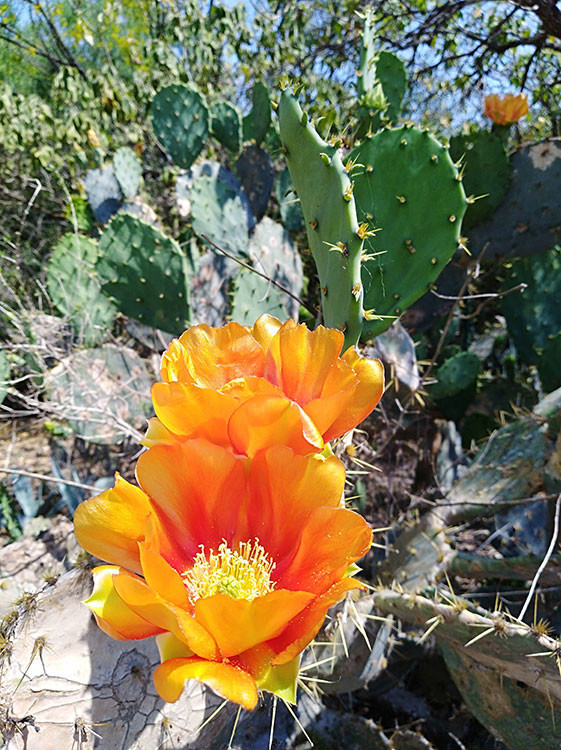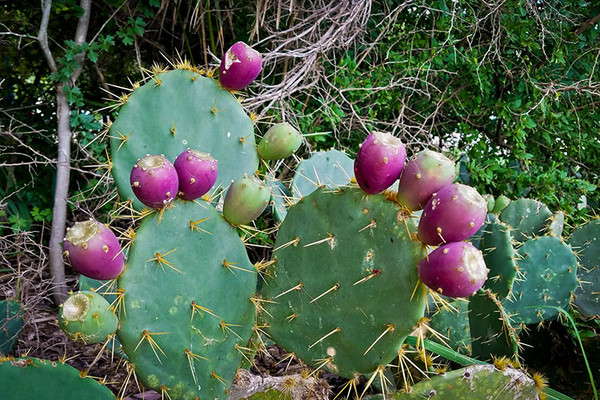 By Colleen Hook, Executive Director at Quinta Mazatlán
By Colleen Hook, Executive Director at Quinta Mazatlán
The best cactus hotel in the world is right in our backyard, the Prickly Pear Hotel. This hotel offers everything from food, water, shelter, medicines and beautiful South Texas landscapes.
So what is there to eat at the Prickly Pear Hotel? Everything, but carefully! The Prickly Pear cactus obviously gets its name from its sharp spines. The cactus is thought to have originated from Mexico and South America and has the ability to grow where there is little water.
The green pads, cactus branches, are called “nopales”. They can be eaten raw in salads but are typically cooked as a vegetable. The nopales flavors are a cross between green beans and okra and have many health benefits. The breakfast of champions is “Nopalitos Con Huevos”, cactus pads with eggs.
The bright red fruit, which look like fingers on the pads, are called “tunas”. You must begin by removing the outer skin of the tuna either over hot coals or rubbing the hairs off with a rock. The tuna is delicious and eaten raw or made into a nectar. The fruit juice is used in candy, jellies, aqua frescas and delicious Prickly Pear Margaritas.
The beautiful cactus also provides shelter and sustenance to many native wildlife in South Texas and Mexico. Inca Doves and Cactus Wrens choose to nest deep within the spiny cactus to provide safe haven for their young. The pads and fruit provide food for wildlife such as javelinas, tortoises and rabbits.
 An insect that feeds on the cactus is the cochineal, sucking juices from the pads. The cactus is approximately 90% water by weight. When the cochineal is crushed, the bug gives off a bright red liquid and has long been used as a dye for food coloring, cosmetics and fabrics. Back in 1521, when the Spanish conquered Mexico, they discovered this beautiful scarlet dye and overtime the scarlet color was used on royalty garments.
An insect that feeds on the cactus is the cochineal, sucking juices from the pads. The cactus is approximately 90% water by weight. When the cochineal is crushed, the bug gives off a bright red liquid and has long been used as a dye for food coloring, cosmetics and fabrics. Back in 1521, when the Spanish conquered Mexico, they discovered this beautiful scarlet dye and overtime the scarlet color was used on royalty garments.
The benefits of Prickly Pear are endless! The cactus is still used today for medicinal purposes such as the treatment of burns, wounds and diabetes. The Texas Prickly Pear is an important source of life for people and wildlife and thus recognized as our Texas State Plant.
Put a Prickly Pear Hotel in your neighborhood; do not let the spines deter you.
Follow Quinta Mazatlán on Facebook, Twitter, Instagram, and Youtube @QuintaMazatlan to learn more about our natural and cultural heritage in the Rio Grande Valley of South Texas.
Photos Courtesy of Jaime Villarreal
The red fruit called “tunas” look like fingers on the Prickly Pear cactus pads. The fruits are in season in the summertime to provide fresh nourishment for people and wildlife.
The Texas Prickly Pear pads, called nopales, provide food for people and wildlife year round. While most cactus are inedible, one can eat the entire Prickly Pear Cactus.
The cactus flowers can come in red, orange and yellow and bloom in the spring.





